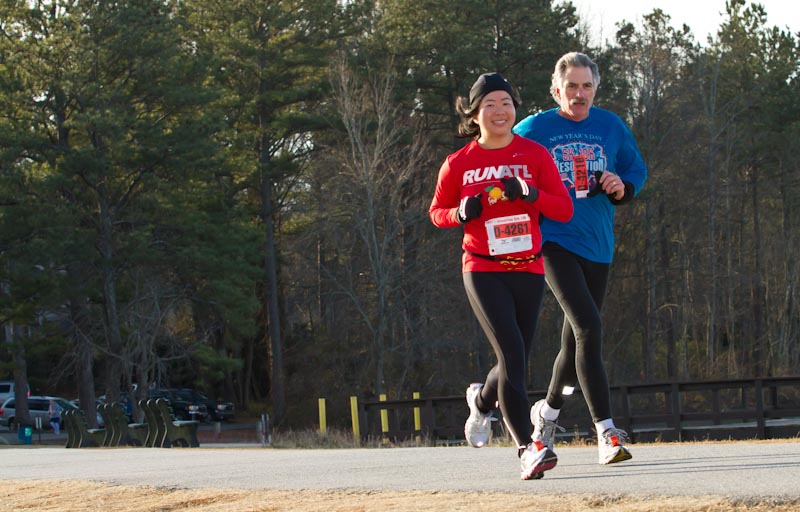“Be Ready to Winter” this season with this field guide to help you through your Winter training.
Runners run. This is the simple truth, regardless of the season. In the words of Brion O’Connor, a correspondent for The Boston Globe, “Whether in snow, sleet, and freezing rain, over patches of black ice or salt-infused slush, runners rarely let anything keep them from their appointed rounds.” This setting undoubtedly sounds like a winter run in Boston – or Minnesota, Michigan, and Wisconsin. Winter is usually frigid and unforgiving, cold and condescending. But this is Georgia, and the weather is topsy-turvy at best. As the saying goes, “If you don’t like the weather in Georgia, wait ten minutes.”

Frankly, there’s no need to tarry for better weather these days as we are greeted with 45-degree mornings and 70-degree afternoons…in January no less. The sun is out and the landscape is ripe to be explored on foot. But let’s suppose for a moment that between now and the end of March that winter does return in full force for one or more days. Let’s further suppose that snow falls furiously from the sky. Punxsutawney Phil did see his shadow recently, so, according to the tradition, winter will linger for six more weeks. Will you be ready? In the event that you need it, consider this article a field guide for winter training when conditions are more hazardous and nastier.
First, remember that daylight is still brief. Daylight Savings Time (DST) will resume in Georgia on Sunday, March 12th, at 2:00 a.m. For now, the sun still sets around 6:00 p.m. Therefore, if you run at dawn or dusk, one simple but profound phrase is paramount to remember, a phrase that I explored in a four-part series last October. See and be seen. Wear reflective clothing (think bright neon colors) and outfit your body with multiple light sources (e.g. a head lamp or flashlight and a few strobe lights) to make the sidewalk or road visible as you move at a quick rate of speed. See and be seen.
Second, winter training will toughen your body and mind. As Nike co-founder and University of Oregon coach Bill Bowerman so eloquently put it, “There’s no such thing as bad weather, just soft people.” Though there are days when conditions might warrant a treadmill run from a safety standpoint, temperatures below forty degrees should not be a turn off for time spent outdoors. Moreover, if you have a spring race on the calendar, runs on the roads will be necessary to better mimic race conditions.
Third, dress appropriately. In other words, dress like it’s fifteen to twenty degrees warmer. With temperatures approaching fifty degrees at 10 a.m. right now, a short sleeve shirt and shorts will suffice. But let me suggest a day in early February when the thermometer reads sixteen degrees at 9 a.m. and a bitter wind is howling. While there are some brave (or is it crazy?) runners who will still reach for a singlet and shorts, the vast majority will opt for tights, wool socks, a long sleeve shirt, a hat, gloves, and jacket.
Fourth, examine your shoe outsole. If freezing rain, sleet, and snow from a rogue February storm produce an icy mixture of slush and black ice on the sidewalks and roads, running shoes with an outsole primarily comprised of blown rubber are unlikely to offer ample traction. Instead, look for a pair with more carbon rubber on the forefoot and heel to grip the ground better. Better yet, consider investing in a pair of trail shoes, which include outsoles that are designed to navigate the gnarly terrain with greater ease.
Fifth, monitor your stride. Incidentally, this principle is a cornerstone of the TransFORMed Running program, available year-round at all seven Big Peach locations. Shortening your stride reduces the likelihood of overstriding, which tends to precede injury. This is vital on snowy sidewalks and roads so you don’t slip and fall to the ground with a thud. Monitoring your surroundings is a complement to this principle. In other words, if you do listen to music during runs, lower the volume to minimize the risk of losing focus of the next step – and the one after that. Be aware.
This is a primer for winter training as there are many additional principles worthy of inclusion in this article. For now, I hope that you will choose to internalize these principles so your runs are completed without incident. Should meteorological conditions take an abrupt turn for the worse in the upcoming weeks, run when daylight is abundant; savor the frigid air; dress for success; check your shoes for durability; and cast your eyes across the landscape for any trouble spots. Run boldly, but safely, as the ice will inevitably thaw in good time and color will burst forth again. Or as Shelley puts it, “If Winter comes, can Spring be far behind?”
Austin Bonds is a Guest Advocate at the Big Peach Suwanee location.


